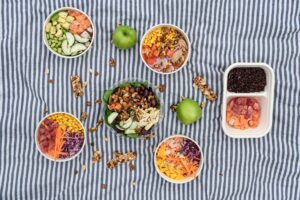How to Transition to AIP: Tips for Beginners Starting Their Autoimmune Healing Journey
Starting the Autoimmune Protocol (AIP) diet can feel overwhelming, especially if you’re new. But don’t worry—AIP for beginners doesn’t have to be difficult. We’ll share practical tips and strategies to help beginners make the switch smoothly so that you can start your autoimmune healing journey with confidence. Whether you want to reduce inflammation, improve gut health, or manage autoimmune symptoms, this step-by-step approach will set you up for success.
Table of Contents
What is AIP?
The Autoimmune Protocol (AIP) is a diet designed to help those with autoimmune conditions manage symptoms by reducing inflammation and healing the gut. AIP eliminates foods; such as grains, legumes, dairy, and processed foods that can trigger an immune response. Instead, it focuses on nutrient-dense whole foods like vegetables, grass-fed meats, and healthy fats.
This approach to eating is specifically tailored to reduce pain and repair the body from within—making it a powerful tool for those struggling with autoimmune disorders.

Why Transitioning to AIP is Essential for Autoimmune Healing
Transitioning to AIP is more than just a diet change; it’s a lifestyle shift that focuses on nourishing your body and eliminating potential inflammatory triggers. For many, it has led to noticeable improvements in symptoms like fatigue, joint pain, and digestive issues. By allowing your body to heal, AIP can help restore balance and promote long-term wellness. Studies suggest that dietary interventions like AIP can play a crucial role in managing autoimmune diseases by targeting inflammation at the root cause.
Step-by-Step Guide to Transitioning to AIP
Start with Research
Knowledge is power! Before diving in, it’s important to educate yourself on the AIP framework. Familiarize yourself with the foods you can enjoy, and the ones you need to avoid. Read blogs, listen to podcasts, and consult AIP resources to build your knowledge base. Knowing what to expect will make the transition smoother.
Prepare Your Pantry
A successful transition starts in your kitchen. Stock your pantry with AIP-approved staples like grass-fed meats, leafy greens, bone broth, coconut oil, and fresh herbs. You’ll also need to eliminate inflammatory foods such as grains, legumes, nuts, seeds, and nightshades (like tomatoes and peppers), there are others but let’s keep it simple here.
With a well-stocked pantry, you can quickly prepare meals without having to worry about finding the right ingredients. This makes it easier to stick to your dietary plan and avoid foods that could worsen symptoms.

Meal Planning is Key
One of the biggest challenges during the AIP transition is meal planning. To make it easier, plan your meals. Batch cook on weekends to save time during the week, and make a weekly grocery list to ensure you have all the ingredients you need. Simple, one-pot meals like soups or slow-cooked meats are great options for beginners.
The immune system is already working in overdrive in autoimmune conditions. When you consume foods that your body struggles to handle, it may cause further immune confusion and lead to more aggressive attacks on the body’s tissues.
Take it Slow: Gradual Transition Tips
Not everyone can jump into AIP overnight. A gradual transition allows you to ease into the diet without feeling overwhelmed. You can start by eliminating one food group at a time—beginning with gluten and processed foods. Once you’re comfortable, phase out dairy, grains, and other inflammatory foods.
Managing Cravings and Emotional Eating
Cravings are natural when you cut out familiar foods like sugar, bread, and dairy. Stay hydrated, keep AIP-compliant snacks on hand (like sweet potato chips or coconut fat bombs), and remind yourself why you’re making these changes. Emotional eating can also be a hurdle, but mindfulness and journaling can help you stay focused.
Relying on food for emotional comfort can create a cycle where poor eating habits make you feel mentally and physically worse, which can lead to more emotional distress and continued unhealthy eating patterns.
Disrupts Healing: Since emotional eating often involves foods that don’t support autoimmune healing, it can slow recovery and make managing symptoms more challenging. Making mindful food choices, especially when feeling emotionally vulnerable, is key to supporting your body through the healing process.
Common Mistakes to Avoid: As you transition to AIP, it’s easy to make some common mistakes:

- Being too restrictive too quickly: Gradually easing into AIP is key to avoiding burnout.
- Relying on processed AIP snacks: While there are packaged AIP-friendly products, it’s best to focus on whole, nutrient-dense foods.
- Not prepping enough: Failure to meal prep can lead to temptations when you’re hungry and short on time. Stay prepared with AIP-approved meals ready to go.
- The immune system is already working in overdrive in autoimmune conditions. When you consume foods that your body struggles to handle, it may cause further immune confusion and lead to more aggressive attacks on the body’s tissues.
Staying Motivated on Your AIP Journey
Staying motivated is crucial to success. Set realistic expectations—healing takes time. Track your progress by keeping a food and symptom journal. You’ll notice which foods trigger symptoms and which ones make you feel better. Surround yourself with support by joining AIP communities online or finding an accountability partner. Most importantly, celebrate small victories along the way!
Conclusion
Transitioning to AIP can seem overwhelming at first, but by taking it one step at a time, you’ll find that it’s a sustainable and rewarding journey. Remember, the goal is not perfection—it’s healing. With proper planning, a gradual approach, and the right mindset, you can successfully transition to AIP and start seeing the benefits in your autoimmune health.
Want more information? Click Here




